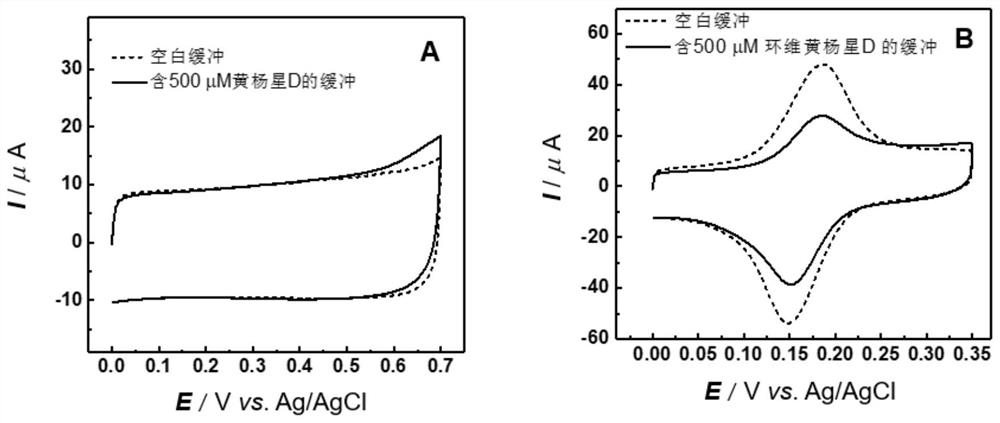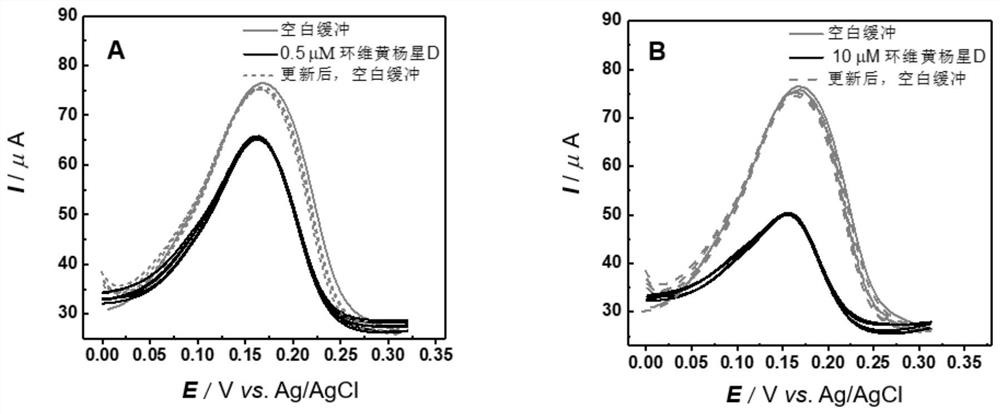Electrochemical sensor, device and method for detecting cyclovirobuxine D
A cycloviral buxicine and detection method technology, which is applied in the field of analytical chemistry, can solve the problems of high analysis cost, large amount of reagent consumption, and complicated preparation process, and achieve simple modification and preparation process, small amount of reagent and sample consumption, and simple equipment Effect
- Summary
- Abstract
- Description
- Claims
- Application Information
AI Technical Summary
Problems solved by technology
Method used
Image
Examples
Embodiment 1
[0050] Carbon nanotube modified glassy carbon electrode and poly-bromothymol blue / carbon nanotube modified glassy carbon electrode are used for electrochemical measurement of cycloviric buxillus D according to the following scheme:
[0051] (1) preparing glassy carbon electrodes modified by carbon nanotubes;
[0052] (2) Carrying out the electrochemical measurement of ring-dimensional buxillus D with the glassy carbon electrode modified by carbon nanotubes in step (1) as the working electrode;
[0053] (3) prepare poly-bromothymol blue / carbon nanotube modified glassy carbon electrode;
[0054] (4) Using the glassy carbon electrode modified by poly-bromothymol blue / carbon nanotubes in step (3) as the working electrode, the electrochemical measurement of Cyclovitamin D was carried out.
[0055] Wherein, the glassy carbon electrodes modified by carbon nanotubes in the step (1) are prepared in 3 groups according to the following method:
[0056] Group 1: Polish the glassy carbon...
Embodiment 2
[0069] A glassy carbon electrode modified with poly-bromothymol blue / carbon nanotubes was used as the working electrode, Ag / AgCl (1M KCl) was used as the reference electrode, and a platinum counter electrode was used as the counter electrode.
[0070] (1) The glassy carbon electrode modified with poly-bromothymol blue / carbon nanotubes was firstly subjected to differential pulse scanning in 0.1M phosphate buffer (pH=7.4), and then placed in 0.1 Differential pulse scans were performed in M phosphate buffer (pH=7.4). After taking it out, the electrode is at 50U·mL -1 After soaking in heparin solution for 5 minutes, differential pulse scanning was performed in blank 0.1M phosphate buffered saline.
[0071] (2) Repeat step (1) seven times, the experimental results are as follows figure 2 As shown in A.
[0072] (3) The poly-bromothymol blue / carbon nanotube-modified glassy carbon electrode was firstly subjected to differential pulse scanning in 0.1M phosphate buffer (pH=7.4) ...
Embodiment 3
[0076] (1) Repeat step (3) of Example 1.
[0077] (2) The poly-bromothymol blue / carbon nanotube-modified glassy carbon electrode obtained in step (1) was first immersed in a 0.1M blank phosphate buffer solution (pH=7.4) for differential pulse scanning. Subsequently, the poly-bromothymol blue / carbon nanotube-modified glassy carbon electrode was immersed in a 0.1M phosphate buffer solution of cyclovirbuxine D at different concentrations (0.01-50 μM) for 20 minutes, and then the electrode was taken out Wash with secondary water to remove the cycloviral buxillus D physically adsorbed on the working electrode, and then place it in the blank phosphate buffer solution for differential pulse scanning. The results are as follows: image 3 As shown in A.
[0078] (3) the relative value I of the peak current change on the differential pulse voltammetry curve recorded by the electrode in step (2) 0 -I / I 0 The linear correction was performed on the poly-bromothymol blue / carbon nanotube ...
PUM
| Property | Measurement | Unit |
|---|---|---|
| diameter | aaaaa | aaaaa |
| length | aaaaa | aaaaa |
Abstract
Description
Claims
Application Information
 Login to View More
Login to View More - R&D
- Intellectual Property
- Life Sciences
- Materials
- Tech Scout
- Unparalleled Data Quality
- Higher Quality Content
- 60% Fewer Hallucinations
Browse by: Latest US Patents, China's latest patents, Technical Efficacy Thesaurus, Application Domain, Technology Topic, Popular Technical Reports.
© 2025 PatSnap. All rights reserved.Legal|Privacy policy|Modern Slavery Act Transparency Statement|Sitemap|About US| Contact US: help@patsnap.com



